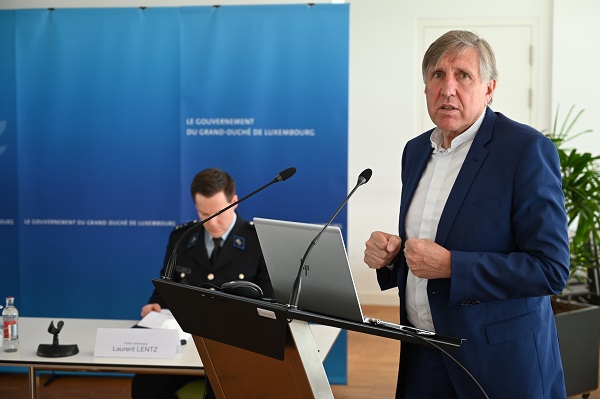 L-R: Laurent Lentz, Police Lëtzebuerg; François Bausch, Luxembourg's Minister of Mobility and Public Works;
Credit: MMTP
L-R: Laurent Lentz, Police Lëtzebuerg; François Bausch, Luxembourg's Minister of Mobility and Public Works;
Credit: MMTP
On Monday 8 June 2020, Luxembourg's Deputy Prime Minister and Minister of Mobility and Public Works, François Bausch, presented details of the the entry into service of the first average speed camera road section in the Grand Duchy.
In 2016, the first ten fixed speed cameras were installed with the aim of increasing road safety in Luxembourg. By 2019, fifteen additional radars had been installed. Luxembourg currently has 24 fixed speed cameras, two trailer speed cameras, five mobile speed cameras and one section speed camera to replace one of the fixed speed cameras.
For the year 2019, a total of 282,703 speeding tickets were issued, including 272,102 €49 fines and 10,601 €145 fines. 2,023 high-speed offences were observed.
The first speed camera section installed in Luxembourg will be put into service on 15 June 2020 and will control a 3.8 km section on the N11 between Waldhof and Gonderange where the maximum authorised speed is 90 km / h for cars and 75 km / h for heavy goods vehicles.
Two speed camera columns, fitted with infrared cameras and detection equipment, are installed at the two ends of the section concerned. At both the entry and exit of the section, vehicles are identified by their registration plates. The average vehicle speed between entering and leaving the section is calculated. If it exceeds the limit, a photo is taken and transmitted to the central office of the automated control and sanctions centre (Centre de contrôle et sanctions automatisés). All other data is deleted.
Minister François Bausch also reiterated his desire to install a red light camera radar in Place de l'Étoile in December 2020 / January 2021. This will be reinforced by the additional installation of two red light radars in Hollerich and Schlammestee during the year 2021.
Minister Bausch stressed: “Radars are used to save lives. Shortly, we will present the accident report for 2019, which is considerably less serious than in previous years. We have only one goal: to reduce the number of seriously injured and fatal victims".









